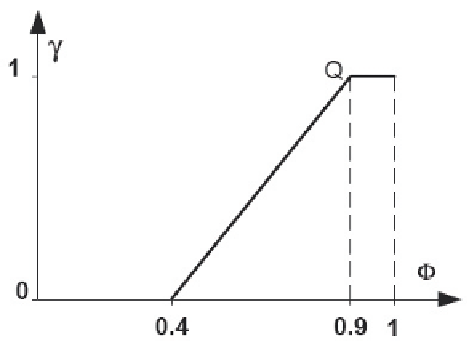Database Reference
In-Depth Information
Figure 2: Relative fuzzy quantifi er “almost all”:
Φ
[0.4, 0.9]
↔
Q(
Φ
Q( ) = 2(
) = 2( - 0.4)
Q(
Φ
Φ
Φ
) = 2(
) = 2(
Φ
Φ
Q
abs
:
R
→ [0, 1]
Q
rel
: [0, 1] → [0, 1]
(3)
where the domain of
Q
rel
is [0,1] because the division
a/b
∈ [0,1], where
a
is the number of
elements fulfi lling a certain condition and
b
is the total number of elements in existence.
In order to know the fulfi llment degree of the quantifi er over the elements which fulfi l a
certain condition, we apply the function
Q
of the quantifi er to the value of quantifi cation
Φ:
a
si
Q
=
Q
abs
Φ =
(4)
a
/
b
si
Q
=
Q
rel
Thus, the fulfi llment degree is
Q
(Φ). If
Q
(Φ)=1, it indicates that this quantifi er is com-
pletely satisfi ed. The value 0 indicates, on the other hand, that the quantifi er is not fulfi lled at
all. Any intermediate value indicates an intermediate fulfi llment degree for the quantifi er.
Example 1.
“Approximately_8” is an absolute fuzzy quantifi er, defi ned as shown
in Figure 1, with n=8, and the margin m=3, for example. “Almost_all” is a relative fuzzy
quantifi er, defi ned as shown in Figure 2.
THRESHOLDS, FUZZY QUANTIFIERS AND
DEGREES FOR OUR APPLICATION
Applied in the context of databases, the usefulness of fuzzy quantifi ers is shown by
the fl exibility it offers to carry out queries which involve these quantifi ers, as for example
in the division operation of relational algebra in fuzzy or classical databases (Galindo et al.,
2001a). Applied in the context of conceptual data models, fuzzy quantifi ers allow expres-
sions about the number of instances which satisfy a given condition, or the proportion with




